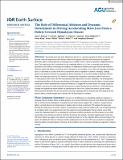The role of differential ablation and dynamic detachment in driving accelerating mass loss from a debris-covered Himalayan glacier
Abstract
Sustained mass loss from Himalayan glaciers is causing supraglacial debris to expand and thicken, with the expectation that thicker debris will suppress ablation and extend glacier longevity. However, debris-covered glaciers are losing mass at similar rates to clean-ice glaciers in High Mountain Asia. This rapid mass loss is attributed to the combined effects of; (1) low or reversed mass balance gradients across debris-covered glacier tongues, (2) differential ablation processes that locally enhance ablation within the debris-covered section of the glacier, for example at ice cliffs and supraglacial ponds, and (3) a decrease in ice flux from the accumulation area in response to climatic warming. Adding meter-scale spatial variations in supraglacial debris thickness to an ice-flow model of Khumbu Glacier, Nepal, increased mass loss by 47% relative to simulations assuming a continuous debris layer over a 31-year period (1984?2015 CE) but overestimated the reduction in ice flux. Therefore, we investigated if simulating the effects of dynamic detachment of the upper active glacier from the debris-covered tongue would give a better representation of glacier behaviour, as suggested by observations of change in glacier dynamics and structure indicating that this process occurred during the last 100 years. Observed glacier change was reproduced more reliably in simulations of the active, rather than entire, glacier extent, indicating that Khumbu Glacier has passed a dynamic tipping point by dynamically detaching from the heavily debris-covered tongue that contained 20% of the former ice volume.
Citation
Rowan , A V , Egholm , D L , Quincey , D J , Hubbard , B , King , O , Miles , E S , Miles , K E & Hornsey , J 2021 , ' The role of differential ablation and dynamic detachment in driving accelerating mass loss from a debris-covered Himalayan glacier ' , Journal of Geophysical Research - Earth Surface , vol. 126 , no. 9 , e2020JF005761 . https://doi.org/10.1029/2020JF005761
Publication
Journal of Geophysical Research - Earth Surface
Status
Peer reviewed
ISSN
2169-9003Type
Journal article
Description
This research was supported by the ‘EverDrill’ Natural Environment Research Council (NERC) Grant awarded to the Universities of Leeds and Sheffield (NE/P00265X) and Aberystwyth University (NE/P002021). KM was supported by an AberDoc PhD studentship. JH was supported by a NERC ACCE DTP studentship (NE/L002450/1).Collections
Items in the St Andrews Research Repository are protected by copyright, with all rights reserved, unless otherwise indicated.

